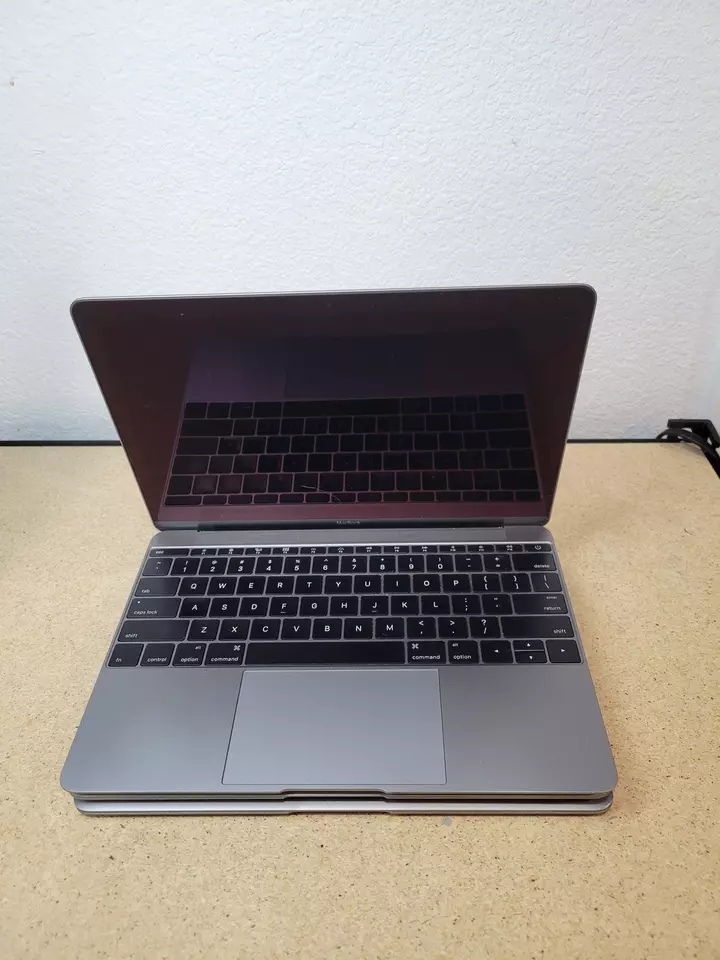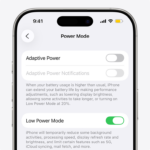Facing a black screen on your MacBook can be frustrating and scary, especially when you need your computer for work or school. This common problem can happen to any MacBook model, whether it’s brand new or a few years old. To fix a black MacBook screen, start by performing a hard restart by holding down the power button for 10 seconds, then try resetting the NVRAM by pressing Option + Command + P + R during startup until you hear the second startup chime.
Many black screen issues can be fixed with simple troubleshooting steps that don’t require technical skills. The problem might be as simple as a drained battery, a display brightness set too low, or a temporary system glitch that needs a restart. Other times, it could be related to software updates or conflicts that need more specific solutions.
⚠️ Symptoms of the Black Screen Issue
You might experience:
- A black or dark screen even though the MacBook is powered on.
- The keyboard lights or fans are running, but nothing appears on the display.
- The Apple logo or login screen never appears.
- The screen flashes once and goes black again.
🧭 Quick Fixes (Try These First)
Before diving into deeper troubleshooting, start with these simple fixes:
1. Check Display Brightness
- Press the F2 (brightness up) key several times.
- On newer MacBooks with Touch Bar, slide the brightness control to maximum.
Sometimes, the brightness is simply turned all the way down.
2. Wake the Screen
- Tap any key or click the trackpad.
- Press the Power button once (don’t hold it) — this can wake the display from sleep.
If the screen stays black, continue below.
3. Force Restart Your MacBook
- Hold down the Power button for 10 seconds until the device fully shuts down.
- Wait a few seconds, then press Power again to restart.
If you see the Apple logo, your issue may have been a temporary crash.
🔋 Power & Connection Checks
4. Check Power Supply
- Plug in your charger and ensure it’s working.
- Try a different power adapter or cable if possible.
- On MacBooks with MagSafe, check for the charging indicator light (amber or green).
If your battery is completely drained, leave it charging for 10–15 minutes before turning it on again.
5. Disconnect Peripherals
Unplug all external devices (USB drives, monitors, hubs, etc.).
Sometimes, connected devices can prevent macOS from booting properly.
🧰 Intermediate Fixes
6. Reset NVRAM / PRAM
This resets display and startup settings.
- Turn off your MacBook.
- Turn it on and immediately press and hold:
Option + Command + P + R - Keep holding for about 20 seconds, then release.
Your MacBook will restart with fresh display settings.
(Note: On Apple Silicon Macs — M1, M2, M3 — NVRAM resets automatically, so you can skip this step.)
7. Reset the SMC (System Management Controller)
For Intel-based MacBooks:
- Shut down your MacBook.
- Press and hold Shift + Control + Option (on the left side) and the Power button simultaneously for 10 seconds.
- Release all keys, then press Power to turn it on.
For Apple Silicon (M1, M2, M3) Macs:
- Just shut down your MacBook and wait 10 seconds, then power it back on — the SMC resets automatically.
8. Boot into Safe Mode
Safe Mode starts macOS with only essential drivers, helping identify software issues.
- Apple Silicon (M1/M2/M3):
- Turn off your MacBook.
- Press and hold the Power button until you see “Loading startup options.”
- Select your startup disk → hold Shift → click Continue in Safe Mode.
- Intel Mac:
- Turn on your MacBook and immediately press and hold Shift.
- Release when you see the login screen.
If your screen works in Safe Mode, a login item or third-party app may be causing the issue.
🧑💻 Advanced Fixes
9. Reset Display Settings in macOS Recovery
If your display settings are corrupted, resetting them can help.
- Boot into macOS Recovery:
- Apple Silicon: Hold Power until “Loading startup options” appears → choose Options → Continue.
- Intel: Turn on and hold Command + R.
- In the menu bar, open Utilities → Terminal.
- Type the following command and press Enter:
defaults delete /Library/Preferences/com.apple.windowserver.plist - Restart your MacBook.
10. Reinstall macOS
If none of the above works, reinstall macOS without erasing your data.
- Boot into Recovery Mode.
- Choose Reinstall macOS and follow the on-screen instructions.
- After reinstalling, check if the screen displays normally.
🧩 Hardware-Related Solutions
11. Check for Display or Logic Board Issues
If your MacBook powers on but the screen remains black:
- Connect an external monitor using HDMI or USB-C.
- If the external display works, your MacBook screen or display cable may be faulty.
- If both screens are black, it could be a logic board or GPU issue.
In either case, contact Apple Support or visit an Apple Authorized Service Provider.
🆘 When to Contact Apple Support
Get professional help if:
- The MacBook screen stays black after all steps.
- You hear startup sounds but see no display.
- The device shows a flickering or dim backlight.
- You suspect liquid damage or a hardware failure.
👉 Visit Apple Support: If your Mac starts up to a blank screen for official instructions.
✅ Summary: Quick Fix Checklist
| Step | Fix | Works On |
|---|---|---|
| 1 | Increase brightness | All models |
| 2 | Force restart | All models |
| 3 | Check power & charger | All models |
| 4 | Reset NVRAM/SMC | Intel Macs |
| 5 | Safe Mode boot | All models |
| 6 | Reinstall macOS | All models |
| 7 | Contact Apple Support | If hardware issue |
🧾 Sources & References
- Apple Support – If your Mac starts up to a blank screen
- iFixit – MacBook Black Screen Troubleshooting
- iBoysoft – MacBook Black Screen Fixes
- MacMyths – 18 Ways to Fix MacBook Black Screen
Key Takeaways
- Hard restart your MacBook and reset the NVRAM/PRAM to quickly fix most black screen issues.
- Check your display brightness, power connections, and try connecting to an external monitor to determine if it’s a display problem.
- If basic steps fail, boot into Safe Mode or Recovery Mode to fix software-related black screen problems.
Identifying the Issue
When your MacBook Pro shows a black screen, finding the root cause is your first step to fixing it. The problem could stem from either hardware damage or software glitches that prevent your display from working properly.
Differentiating Hardware from Software Problems
Hardware problems often show physical signs. If your MacBook Pro makes startup sounds but shows a black screen, the logic board or display might be damaged. Look for visible cracks on the screen or liquid damage indicators that have turned red.
Software issues typically allow some interaction with your Mac. You might notice:
- The keyboard backlight turns on
- External displays work when connected
- The power button responds normally
- Fan noises or startup chimes are present
Try connecting an external monitor to your MacBook. If the external screen works, your MacBook’s display hardware likely needs repair. If neither screen works, you’re probably facing a software problem.
Signs of Black Screen Issues
Several indicators can help pinpoint your black screen problem. A completely dead MacBook Pro shows no signs of life—no lights, sounds, or vibrations when pressing the power button.
Partial functionality suggests fixable issues. Watch for these clues:
- Sleep indicator light is on (pulsing)
- Keyboard backlight illuminates
- Apple logo appears briefly before screen goes black
- Computer makes normal startup sounds but display remains dark
- Screen backlight is dimly visible in dark room
The timing of the black screen matters too. If it happens during startup, try resetting NVRAM/PRAM by holding Command+Option+P+R during restart. If it happens randomly during use, the display connection might be loose or software is crashing.
Initial Troubleshooting Steps
When facing a black screen on your MacBook Pro, starting with simple fixes often solves the problem without needing technical help. These basic steps can quickly restore your screen to normal functioning.
Restart Your MacBook Pro
If your MacBook Pro shows a black screen, try a force restart first. This simple step often fixes temporary software glitches.
Hold down the power button for 10 seconds until your Mac turns off completely. After a brief pause, press the power button again to restart. This forces your Mac to restart and can resolve many black screen issues.
If a normal restart doesn’t work, try a specialized key combination. Press and hold the Command + Option + P + R keys simultaneously after pressing the power button. Keep holding these keys until you see the Apple logo appear twice. This resets your computer’s NVRAM and can fix display problems.
Wait for your MacBook to complete the startup process. If the screen remains black, continue to the next step.
Check Power Supply and Adapter
Power issues often cause black screens on MacBooks. First, check if your battery has any charge left.
Look for these signs of power problems:
- Power adapter light not turning on
- No charging indicator when plugged in
- MacBook feeling completely cold (not even warm)
Try a different power outlet to rule out electrical problems in your current outlet. Also, examine your power cable and adapter for any visible damage like fraying, bends, or discoloration.
Test with another power adapter if possible. Many black screen issues happen because the MacBook isn’t getting proper power. If your friend has a compatible charger, borrowing it can help determine if your adapter is the problem.
Make sure the connections are secure at both the wall outlet and MacBook port. Sometimes, a loose connection can prevent proper charging and cause the MacBook Pro screen to remain black.
Advanced Troubleshooting Techniques
When basic fixes don’t work for your black MacBook screen, these specialized methods can often bring your display back to life. These techniques target the core system components that control your display and startup functions.
Boot into Safe Mode
Safe Mode starts your Mac with only essential software, which can help fix a black screen issue when software conflicts are the cause.
To enter Safe Mode on Intel Macs:
- Shut down your MacBook completely
- Press the power button
- Immediately hold the Shift key
- Release Shift when you see the login screen
For M1/M2 Macs:
- Shut down your Mac
- Press and hold the power button
- When startup options appear, select your startup disk
- Hold Shift key while clicking “Continue in Safe Mode”
If your screen works in Safe Mode, the problem is likely with third-party software. Try removing recently installed apps or updates that might be causing conflicts.
Reset SMC (System Management Controller)
The SMC controls many hardware functions including display, power, and battery management. Resetting it often fixes stubborn screen problems.
For MacBooks with non-removable batteries:
- Shut down your MacBook
- Connect the power adapter
- Press Shift+Control+Option and the power button at the same time
- Hold for 10 seconds, then release
- Press the power button to turn on your Mac
For newer MacBooks with T2 chip:
- Shut down your MacBook
- Press and hold the power button for 10 seconds
- Release and wait a few seconds
- Press the power button to restart
M1/M2 Macs don’t need a special SMC reset—simply shut down and restart after waiting 30 seconds.
Reset PRAM/NVRAM
PRAM/NVRAM stores settings like screen resolution and brightness, which can cause display problems when corrupted. Resetting these settings often helps with black screen issues.
For Intel Macs:
- Shut down your MacBook
- Press the power button
- Immediately press and hold Command+Option+P+R
- Hold these keys for about 20 seconds
- Release when you hear the startup sound twice or see the Apple logo appear and disappear twice
For M1/M2 Macs, NVRAM resets automatically when needed, but you can still try the manual method:
- Shut down your Mac
- Wait 5 seconds
- Restart and immediately press Command+Option+P+R
- Hold for 20 seconds, then release
After the reset, you may need to readjust display settings like resolution and brightness.
Software-Related Solutions
Black screen issues on your MacBook often stem from software problems rather than hardware failures. These can range from minor glitches to more serious system errors that need specific approaches.
Reinstall macOS
When your MacBook shows a black screen that won’t go away, reinstalling macOS might fix the problem. To do this, you’ll need to start your Mac in Recovery Mode.
Turn off your MacBook completely by holding the power button for 10 seconds. Then restart while holding Command+R until you see the Apple logo or a spinning globe.
Once in Recovery Mode, select “Reinstall macOS” from the utilities window. This installs a fresh copy of the operating system without erasing your files.
If your screen remains black during this process, try connecting to an external monitor. This helps determine if the issue is with your display or the system itself.
For newer M1/M2 Macs, the process differs slightly. Press and hold the power button until startup options appear, then select Options and continue to Recovery.
Resolve Software Glitches
Many black screen problems come from simple software glitches that can be fixed without reinstalling the whole system.
Reset NVRAM/PRAM:
- Shut down your MacBook
- Turn it on and immediately press Command+Option+P+R
- Hold these keys for about 20 seconds
- Release when you hear the startup sound twice or see the Apple logo appear and disappear twice
Reset the SMC (System Management Controller):
For MacBooks with non-removable batteries:
- Shut down your Mac
- Press Shift+Control+Option and the power button together
- Hold for 10 seconds
- Release all keys and press the power button to turn on your Mac
Boot in Safe Mode by holding the Shift key during startup. This loads only essential software and can help identify if third-party apps are causing problems.
Update or Downgrade macOS
Running outdated software or a problematic update can cause black screen issues on your MacBook. Keeping your system updated helps prevent these problems.
Check if your black screen started after upgrading to a newer version like Mojave or Catalina. Some users report display issues after specific updates.
To update macOS (if you can access your system):
- Go to System Preferences > Software Update
- Install any available updates
- Restart your MacBook when prompted
If a recent update caused your black screen, consider downgrading to the previous version. This requires erasing your drive and reinstalling an older macOS version from Recovery Mode.
Before downgrading, back up your important files if possible. Then use Internet Recovery (Command+Option+Shift+R during startup) to install the macOS version that came with your Mac or the closest available version.
Dealing with Potential Hardware Issues
Sometimes a black screen on your MacBook may point to hardware problems rather than software glitches. These issues can range from display connection failures to more complex problems with newer Apple Silicon models.
Inspecting External Displays
When facing a black screen, try connecting an external display to determine if the issue is with your built-in screen. If the external monitor works, your MacBook’s display hardware might be damaged.
Follow these steps to test with an external display:
- Connect your MacBook to an external monitor using the appropriate cable
- If the external display shows your desktop, your built-in screen may have failed
- Check for loose connections or damaged cables before assuming screen failure
Look for physical damage signs on your MacBook screen such as cracks or liquid damage. These often require professional repair services.
Some users report success by gently applying pressure near the screen hinges, but this is only a temporary fix for loose connections. For permanent solutions, Apple repair services are recommended.
Addressing Apple Silicon Concerns
Apple Silicon MacBooks (M1, M2, etc.) sometimes have unique display issues that need specific troubleshooting steps. These newer models have integrated systems that respond differently to hardware reset procedures.
For Apple Silicon MacBooks with black screens:
- Shut down completely by holding the power button for 10 seconds
- Wait 30 seconds before restarting
- Press the power button once (don’t hold it) to restart normally
If startup chimes or keyboard lights work but the screen stays black, try these Apple Silicon-specific steps:
- Connect to an external display to check if macOS is running
- Reset the SMC by shutting down, then hold Control + Option + Shift for 7 seconds, then add the power button
- Update firmware if possible through recovery mode
Hardware issues with Apple Silicon models often require Apple’s diagnostic tools, so consider booking a Genius Bar appointment for persistent problems.
Data Recovery Strategies
When your MacBook shows a black screen, recovering your data becomes a top priority. Proper backups and specialized tools can help you save important files even if your Mac won’t boot properly.
Using Time Machine Backup
Time Machine is Apple’s built-in backup solution that can save your data when your screen goes black. If you’ve set up Time Machine before the black screen problem, you’re in luck.
To recover your files:
- Connect your Time Machine backup drive to a working Mac
- Restart the working Mac while holding the Command + R keys to enter Recovery Mode
- Select “Restore From Time Machine Backup” in the macOS Utilities window
- Follow the on-screen instructions to select your backup disk and date
Time Machine keeps multiple versions of your files, letting you pick the most recent backup before the screen failure occurred.
You can also connect your broken MacBook to another Mac using Target Disk Mode by holding the T key during startup. This turns your MacBook into an external drive for data access.
Leveraging Data Recovery Tools
When Time Machine isn’t available, data recovery software can help rescue your files. These programs can scan your drive and retrieve lost data.
EaseUS Data Recovery Wizard is a popular option for MacBooks with black screens. This tool can recover photos, videos, documents, and more from unbootable Macs.
To use data recovery tools:
- Remove the hard drive from your MacBook (or use Target Disk Mode)
- Connect it to a working computer
- Install and run the recovery software
- Scan the drive and select files to recover
Some users have successfully recovered data by using Disk Utility’s disk image feature. This creates a complete copy of your drive that you can mount and browse like a normal folder.
For valuable data, consider professional data recovery services if DIY methods fail.
Professional Support Options
When faced with a persistent black screen on your MacBook, seeking professional help might be your best option. Apple offers several ways to get expert assistance with complex issues.
Contacting Customer Support
Apple provides multiple ways to reach their customer support team. You can contact Apple Support directly through their website, phone line, or the Apple Support app.
Before calling, have your MacBook’s serial number ready. This helps representatives check your warranty status and service options.
Apple Support can:
- Schedule appointments at Apple Stores
- Arrange mail-in repairs
- Help troubleshoot over the phone
- Connect you with authorized service providers
For urgent issues, using the Apple Support app lets you chat with a representative quickly. Remember that repairs for black screen issues may be covered under warranty if your device is eligible.
Consulting with Tech Support Experts
Independent tech experts can offer alternative solutions when Apple Support isn’t available. Platforms like JustAnswer connect you with certified technicians who can guide you through fixing black screen problems.
These experts often provide:
- Step-by-step troubleshooting tailored to your specific model
- Advice on potential hardware issues
- Estimated repair costs
- Tips for preventing future problems
Many computer repair shops specialize in Mac repairs with faster turnaround times than official channels. When choosing a third-party repair service, check reviews and ask about their experience with your MacBook model.
For complex issues like logic board failures causing black screens, consulting a specialist may save time and money compared to trial-and-error approaches.
Frequently Asked Questions
MacBook black screen issues can be fixed with several troubleshooting methods. These solutions range from simple power cycles to more advanced hardware diagnostics.
What should I do when my MacBook screen goes black while it’s still running?
First, check your screen brightness by pressing the brightness up key. Sometimes the screen is simply set too dark.
If that doesn’t work, try a force restart by holding the power button for about 10 seconds. This often resolves temporary software glitches.
Disconnect all external devices and cables. External peripherals sometimes conflict with your display settings.
How can I resolve a black screen with visible lines on my MacBook?
When seeing lines on a black screen, try an SMC and PRAM reset. For PRAM, hold Command + Option + P + R while restarting until you hear the startup sound twice.
Lines often indicate a graphics card issue. Boot in safe mode by holding the Shift key during startup to see if the problem persists.
If the lines remain, the display or graphics hardware may need professional repair.
What steps should be taken when encountering a black screen on MacBook Pro along with startup chime?
If you hear the startup chime but see a black screen, wait a minute as the system may still be loading.
Try connecting an external monitor. If the external display works, your built-in screen might have hardware issues.
Reset the SMC (System Management Controller) by shutting down, holding Shift+Control+Option and the power button for 10 seconds.
Why does my MacBook Air display turn black while the computer remains powered on?
This often happens due to software conflicts or energy saver settings. Check if the power indicator lights are on.
Perform a power cycle by shutting down completely and then restarting. This refreshes system resources.
Update macOS to the latest version, as outdated software can cause display problems.
What are the troubleshooting steps for a MacBook showing a black screen with a movable cursor?
A visible cursor indicates the system is running but has display issues. Try adjusting the brightness using the keyboard controls.
Restart in Safe Mode by holding the Shift key during startup. This loads only essential system components.
Check for problematic applications that might be causing conflicts with your display drivers.
Can a black screen on a MacBook Air be fixed, and if so, how?
Yes, most black screen issues can be fixed. Start with simple solutions like checking the power connection and brightness settings.
Try resetting the NVRAM by holding Command+Option+P+R during startup until you hear the startup sound twice.
Run Apple Diagnostics by holding D while starting up. This identifies potential hardware problems.
If software fixes don’t work, the screen, display cable, or logic board might need professional repair.







